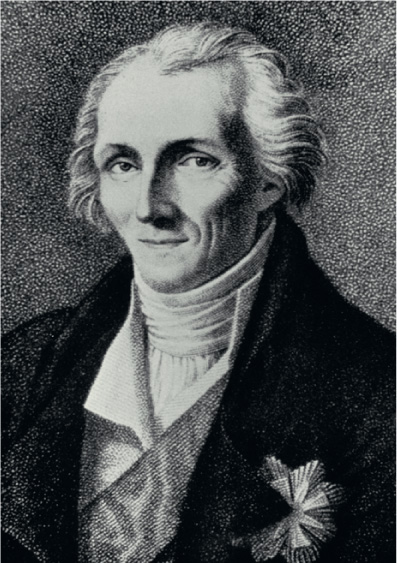
American-British physicist Count Rumford (1753–1814), born Benjamin Thompson.
At the end of the eighteenth century, it was widely thought that the phenomenon of heat was associated with a fluid called caloric, which was contained inside objects rather like the way water is contained in a wet sponge. According to this idea, it was caloric flowing out of an object that caused a rise in temperature. A few people disagreed. In particular, the Dutchman Herman Boerhaave had suggested, decades earlier, that heat might be a form of vibration, like sound. But the experiments proving the caloric theory wrong were carried out only in the 1790s, by a colourful American-born scientist then working in Bavaria.

Benjamin Thompson had been on the wrong (British) side in the American war of Independence, as a result of which he became an itinerant scientist/engineer, finding work wherever he could. This led him to Bavaria, where he was so successful in the service of the Elector (Prince) who ruled the region that in 1792 he was ennobled as Graf von Rumford (in English, Count Rumford). Rumford, as he is usually known, became interested in the nature of heat when carrying out experiments to test the power of gunpowder. He noticed that the barrel of a cannon became hotter if it was fired without being loaded than it did if it was loaded with a cannonball, even though the amount of gunpowder used was the same. This is not what you expect from the caloric model, and he had also read about Boerhaave’s ideas. One of his roles in Bavaria (at the arsenal in Munich) was to oversee and improve the process of boring out the barrels of cannon, and this gave an opportunity to investigate further.
In making cannon, a cylinder of steel was held in place horizontally, pressed up against a non-rotating drill bit. The steel cylinder itself was rotated, using power from horses plodding round in circles and harnessed to the device by a system of gears, while the drill bit was pushed gradually into the hole being bored. The friction between the drill bit and the steel cylinder soon made the cannon hot. Proponents of the caloric model argued that this was because caloric was being squeezed out of the steel. But Rumford was quick to see the flaw in this argument. The supply of heat seemed to be inexhaustible. As long as the boring continued, heat was produced. If caloric was being squeezed out like water out of a sponge, why didn’t it all get used up? Why didn’t the ‘sponge’ dry out?
Using bits of steel left over from the cannon-making which were of no further use, Rumford devised an ingenious experiment. He placed the scrap steel in a wooden box full of water, so that he could measure the amount of heat produced in terms of how long it took to bring the water to the boil (roughly two and a half hours); and he used a dull, discarded drill bit which was little use for boring any more, but which generated a great deal of friction. He found that he could keep on boiling water, refilling the box over and over again, as long as the horses kept walking. The caloric idea disagreed with experiment, so it was wrong. Rumford’s results were published by the Royal Society in 1798.
Back in Bavaria, his experiment became something of a party piece, with visitors being amazed at seeing large amounts of cold water made to boil without the use of fire. But Rumford pointed out to them that this was not an efficient way to boil water, because the horses had to be fed hay. If you simply wanted to boil water, it would be much better to do away with the horses and burn the hay itself. With this remark, Rumford was on the brink of understanding the law of conservation of energy, which, echoing the law of conservation of mass (see here), says that the total amount of energy is conserved, but that energy can be converted from one form into another. He never quite took that step. But he did write: ‘It appears to me to be extremely difficult, if not quite impossible, to form any distinct idea of any thing, capable of being excited and communicated in the manner the Heat was excited and communicated in these experiments, except it be MOTION.’

Rumford had no idea exactly what kind of motion might be involved, although he did draw an analogy with the ringing of a bell, but we now know that heat is indeed associated with the motion of atoms and molecules. It was experiments like this that helped to establish the reality of atoms and molecules, as well as inspiring later researchers, such as James Joule (see here) in their investigation of heat.